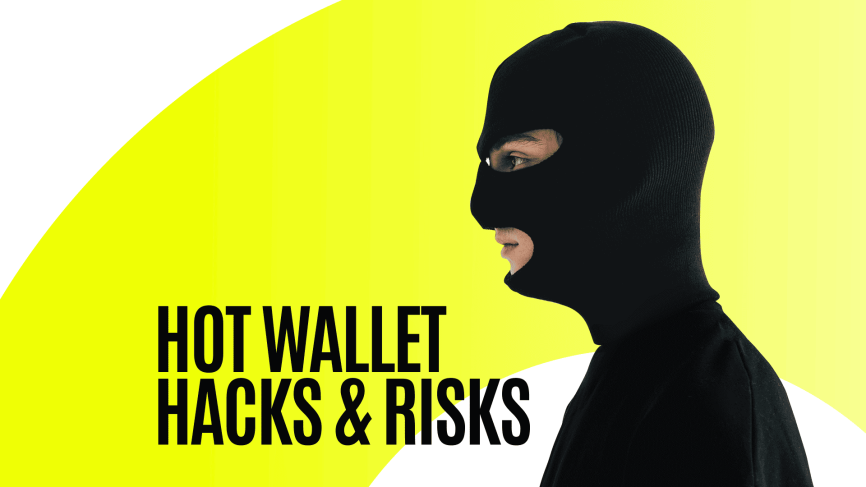Hot Wallet Hacks & Risks: 12 Measures Every Business Should Know

Table of contents:
Hot wallets keep crypto businesses moving. They also make them a target.
One exploit and assets disappear irreversibly. There’s no rollback on the blockchain.
In 2024 alone, over $2.2 billion was stolen in crypto hacks. These weren’t isolated events. They were preventable failures. For any business handling digital assets, hot wallet security isn’t a technical concern, it’s a direct operational risk.
This article breaks down how hot wallets are compromised, what vulnerabilities matter, and how to build effective defenses.
Failure to implement proper controls can increase exposure to cyber threats.
What Is a Hot Wallet?
A crypto wallet doesn’t store coins. It manages cryptographic key pairs that authorize blockchain transactions. The private key enables fund transfers. Without it, crypto can’t be moved.
A hot wallet is a wallet connected to the internet. It enables real-time sending and receiving of digital assets.
Unlike cold wallets, which store keys offline, hot wallets offer accessibility and speed, at the cost of constant exposure to online threats.
Businesses rely on a crypto hot wallet to execute transactions instantly, automate payments, and manage digital assets across multiple platforms and currencies.
Here are the main types of hot wallets:
- Web wallets. Accessed via browser, they run on centralized platforms or third-party sites. Some services manage the private keys (custodial), while others offer full user control (non-custodial). Security depends on the provider’s architecture and the user’s operational hygiene.
- Desktop wallets. Installed on local machines, these wallets store private keys in encrypted files. Control is higher, but risk increases if the system is compromised by malware or unauthorized access.
- Mobile wallets. Mobile wallets are designed for smartphones and support fast QR-based transactions. They are convenient but inherit the device’s vulnerabilities. Theft, loss, or spyware can expose sensitive credentials.
- Exchange wallets. Custodial wallets are offered by centralized exchanges. Users transact via platform credentials but don’t control the private keys. If the exchange is hacked or goes offline, funds may become irretrievable.
Hot Wallet Risks
Hot wallets offer speed and access. But they also expose digital assets to distinct security threats. Each risk stems from the wallet’s online nature and how it interacts with devices, software, and third-party platforms.
Here’s the list of risks associated with hot wallets:
- Permanent internet exposure. Hot wallets are continuously online, which makes them susceptible to remote exploits, malware, and real-time hijacking. In June 2023, attackers breached Atomic Wallet and extracted over $100 million across 5,500 accounts in hours.
- Loss of key control. Custodial wallets often hold user keys on centralized servers. When those servers are compromised, as in the $120 million Poloniex breach, users lose funds instantly, with no recovery path.
- In-memory data leakage. Wallets load private keys and seed phrases into RAM during operation. Advanced attackers can capture these with memory forensics, even without malware present on the device.
- Vulnerabilities in embedded code. Some wallets rely on third-party libraries. If these are outdated or improperly audited, attackers can exploit them to hijack transactions or bypass verification layers.
- Remote Procedure Call (RPC) exploits. Wallets that expose RPC interfaces risk command injection if improperly secured. Attackers can send forged requests to initiate unauthorized transfers without needing the private key.
- Hardware-based credential theft. On USB-debug-enabled devices or unencrypted drives, keys and logs can be extracted manually. Physical access alone may be enough to compromise wallet credentials.
- Trust asymmetry. Hot wallets often verify user identity but fail to verify the authenticity of connected services or software updates. This one-way trust allows attackers to deploy fake updates or redirect traffic to rogue nodes.
Hot Wallet Hacks and Attack Mechanisms
In 2024, digital wallets, often hot wallets, became the primary target for crypto-related attacks, surpassing smart contracts. Access control exploits, which typically involve the theft or misuse of private keys, seed phrases, or administrative credentials, accounted for 78% of all crypto thefts. In contrast, smart contract vulnerabilities were responsible for just 27%.
This shift highlights cybercriminals’ growing focus on real-time access points. Hot wallets often store live funds and rely on always-online infrastructure, which makes them more exposed to credential hijacking and unauthorized access.
Below are the main attack vectors used to compromise hot wallets:
- Phishing. Attackers deploy fake domains, emails, or apps that mimic trusted services. Victims unknowingly input their keys or recovery phrases. In one 2022 case, a fake MetaMask site redirected users and stole over $10 million in ETH.
- Malware. Keyloggers, clipboard hijackers, and remote access tools monitor wallet activity and extract data. Malware often hides in cracked software or counterfeit browser extensions.
- Ransomware. Attackers encrypt wallet files and demand payment for decryption. Some variants steal the keys first, ensuring theft even if the ransom isn’t paid.
- Social engineering. Threat actors impersonate executives or support teams to pressure staff into exposing sensitive credentials. These attacks bypass technical barriers through psychological manipulation.
- Third-party code exploits. Popular apps (including wallets) can be compromised via an outdated dependency. In this case, users lose funds after remote command execution became possible through a library vulnerability.
- DNS hijacking. Attackers redirect traffic to cloned wallet platforms using manipulated DNS entries. In 2018, MyEtherWallet was hit by this vector, leading to rapid asset loss from unsuspecting users.
- Fake wallets and extensions. Cloned wallets appear in app stores or extension marketplaces with near-identical branding. Once installed, these steal credentials or redirect transaction outputs silently.
How to Protect Your Hot Wallet
With a secure crypto wallet for business, your funds will not be compromised. CoinsPaid offers a wallet solution designed to support secure operations, meet regulatory needs, and handle high-volume performance.
The CoinsPaid secure business wallet includes:
- Two independent blockchain risk scoring systems to flag suspicious activity and block high-risk addresses in real-time.
- Diversified treasury management, integrating Ledger Enterprise cold storage to isolate the majority of funds from online exposure.
- CoinsPaid is a solid private company with regular financial and regulatory audits. No critical vulnerabilities reported in the latest independent audit.
Security is built into the core of the CoinsPaid solutions, designed to reduce typical vulnerabilities associated with hot wallets.
"Accepting cryptocurrency is important for future-proofing your business, sure. But, it’s also about tapping into a global market, cutting costs, and offering a more secure, efficient way to transact right now."
Additionally, to stay secure, every business using hot wallets should follow these essential protection measures:
- Keep the majority of funds offline in cold wallets. Transfer only necessary amounts to hot wallets to limit exposure.
- Use hardware-based multi-factor authentication (MFA) to protect private keys and prevent unauthorized access.
- Store all private keys, seed phrases, and transaction data using strong encryption methods. Recovery phrases must be kept offline in secure, tamper-evident locations.
- Run hot wallets on isolated, containerized systems. Remove unnecessary software and restrict operating system privileges to reduce attack surfaces.
- Restrict wallet APIs to trusted IP addresses and applications. Use scoped, time-limited API keys and monitor all activity for irregularities.
- Monitor transactions in real-time. Deploy blockchain analytics tools to detect unusual behavior, such as large withdrawals or interactions with suspicious addresses.
- Limit wallet operations to authorized personnel. Maintain detailed logs of all actions and prevent privilege escalation.
- Choose wallets with a proven security record and regular third-party audits like the one by CoinsPaid. Apply software updates promptly to patch vulnerabilities.
- Perform frequent internal and independent security assessments to identify and address weaknesses.
- Monitor network traffic for signs of compromise or unauthorized access to wallet systems.
- Establish clear procedures to quickly contain breaches, preserve forensic evidence, and communicate with stakeholders.
- Educate staff about phishing, social engineering, and secure handling of credentials to reduce human error risks.
Practical Steps to Protect Your Crypto (Video)
Start your crypto journey today. Watch the video and learn from CoinsPaid experts.
We share simple but powerful steps to keep your digital assets safe — from choosing the right wallet to avoiding common scams.
Discover the world of cryptocurrency with us. Watch the video and learn to build a successful business with CoinsPaid Crypto Academy.
Hot wallets are indispensable to crypto business operations, but they’re also one of the high-value targets in the digital asset ecosystem. The same traits that enable real-time access and automation also create points of failure.
The difference between a secure platform and a compromised one isn’t luck. It’s architecture, discipline, and ongoing vigilance. That’s why many companies in 2025 choose the wallets by CoinsPaid, a provider with secure crypto solutions for businesses engaged in many industries from real estate and hospitality to e-commerce and software.
Ignore hot wallet security, and the next breach could be yours.
Summary
Key Takeaways:
- In 2024 alone, crypto hacks led to $2.2 billion in losses, with 78% of attacks linked to compromised hot wallets.
- Hot wallets provide real-time access for businesses but also expose funds to online threats, malware, and phishing attacks.
- Common vulnerabilities include key mismanagement, third-party code flaws, RPC exploits, and DNS hijacking.
- Security depends on architecture and discipline: cold storage, encryption, API restriction, and real-time monitoring reduce exposure.
- Companies using CoinsPaid’s secure business wallet benefit from built-in compliance, blockchain risk scoring, and Ledger Enterprise cold storage integration.
What this means for your business
Hot wallets speed up operations but raise the exposure of your assets. Layered defense helps mitigate this problem. Use strong access controls, encrypted keys, risk assessment, and cold storage for the bulk of funds. Train your team and implement best practices for operational security. CoinsPaid provides an enterprise-grade wallet with built-in compliance, blockchain risk analytics, and cold storage options, so your digital assets stay safe from different attack vectors.
CoinsPaid delivers enterprise-grade crypto wallet infrastructure designed for performance and security. With real-time blockchain risk analytics, cold storage integration, and 24/7 monitoring, we help businesses protect funds while successfully using crypto in day-to-day financial transactions.




